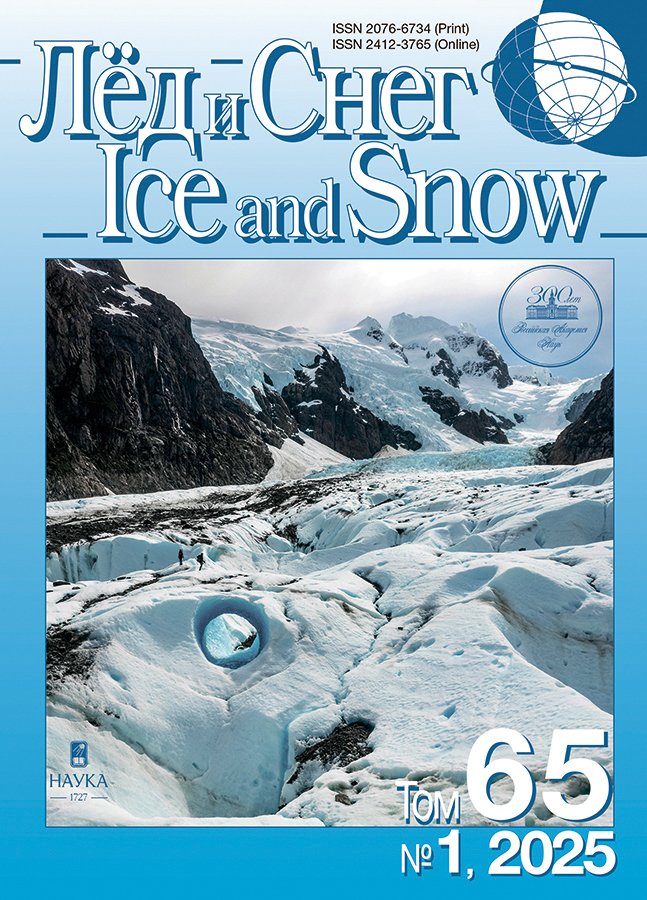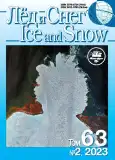Glaciers in the Russian Mountains (Caucasus, Altai, Kamchatka) in the First Quarter of the 21st Century
- Authors: Kotlyakov V.M.1, Khromova T.Y.1, Nosenko G.A.1, Muraviev A.Y.1, Nikitin S.A.1
-
Affiliations:
- Institute of geography RAS
- Issue: Vol 63, No 2 (2023)
- Pages: 157-173
- Section: Glaciers and ice sheets
- URL: https://journals.rcsi.science/2076-6734/article/view/137461
- DOI: https://doi.org/10.31857/S2076673423020114
- EDN: https://elibrary.ru/RVBDMJ
- ID: 137461
Cite item
Full Text
Abstract
The conducted studies allowed us to obtain a detailed picture of glaciation changes in the mountain regions of Russia, most provided with information about glaciers in the twentieth century. For the Caucasus glaciation, the data were obtained for the time periods 1911, 1952, 2000, 2014, 2018 and 2020; for Altai – for 1850, 1952, 2003 and 2018. For large glaciation nodes of the Central Altai – Katun, South and North Chuya Ridges additionally for 1968, 2008, and 2017. In both areas, a decrease in the area of glaciers since the beginning of the twentieth century and acceleration of the rate of reduction in the early twenty-first century have been revealed. The glaciers of the Caucasus and Altai reduced their size during this time by 46% and 48%, respectively. On average, in the twentieth century the glaciers of the Caucasus lost about 0.2% of the area per year, in the Altai – 0.15%, and in the early twentieth century 1.15 and 1.7% respectively. To study Kamchatka glaciers, we used data from the Glacier Inventory of the USSR (1950/1957) and images from different satellites in the period 2007–2019. The glaciers that were not previously registered in the Glacier Inventory of the USSR were identified. The greatest number of such glaciers is in the northern part of the Midnight Ridge, where out of 465 glaciers identified on modern satellite images, 216 were not included in the Glacier Inventory of the USSR. The area of glaciation in different regions of Kamchatka has changed extremely unevenly since the first cataloguing, which is associated with significant differences in glacier morphology. Glaciers of volcanic areas increased their size or remained stationary; here there is no tendency for glaciers to decrease due to the thick surface moraine consisting of volcanogenic material. Comparison of data from the Glacier Inventory of the USSR (as of the 1950s–70s) and the Glacier Inventory of Russia (2017–2019) shows a decrease in glaciation area from the mid-20th century to the end of the second decade of the 21st century in all mountainous regions of Russia except only the volcanic regions of Kamchatka. The area reduction ranges from 63% (Ural) to 13% (Kodar). The largest glacial systems of the Caucasus, Kamchatka and Altai have reduced their areas by 25, 22 and 39%, respectively
Keywords
About the authors
V. M. Kotlyakov
Institute of geography RAS
Email: tkhromova@gmail.com
Russia, Moscow
T. Y. Khromova
Institute of geography RAS
Author for correspondence.
Email: tkhromova@gmail.com
Russia, Moscow
G. A. Nosenko
Institute of geography RAS
Email: tkhromova@gmail.com
Russia, Moscow
A. Y. Muraviev
Institute of geography RAS
Email: tkhromova@gmail.com
Russia, Moscow
S. A. Nikitin
Institute of geography RAS
Email: tkhromova@gmail.com
Russia, Moscow
References
- Atlas snezhno-ledovyh resursov mira. World Atlas of Snow and Ice Resources. Moscow: Russian Academy of Sciences, 1997: 392 p [In Russian].
- Vinogradov O.N. Completion of works on creation of Catalogue of glaciers of the USSR. Materialy Glyatsiologicheskikh Issledovaniy. Data of Glaciological Studies. 1984. 51: 10–16 [In Russian].
- Glazyrin G.E., Muravyev Ya.D., Vinogradov V.N. On the climatic background of Kamchatka glaciation. Materialy Glyatsiologicheskikh Issledovaniy. Data of Glaciological Studies. 1985, 27: 51–66 [In Russian].
- Katalog lednikov SSSR. USSR Glacier Inventory. Moscow, Leningrad: Hуdrometeoizdat, 1965–1982 [In Russian].
- Kotlyakov V.M., Khromova T.E., Zverkova N.M., Chernova L.P., Nosenko G.A. Two new glacial systems in northeastern Eurasia. Doklady Akademii Nauk. Reports of the Academy of Sciences. 2011, 437 (1): 108–113 [In Russian].
- Kotlyakov V.M., Rototaeva O.V., Nosenko G.A., Desinov L.V., Osokin N.I., Chernov R.A. Karmadonskaya katastropha: chto slychilos I chto zhdat dalshe. The Karmadon catastrophe: what happened and what to expect next. Moscow: Publishing house “Kodeks”, 2014a: 184 p [In Russian].
- Kotlyakov V.M., Khromova T.E., Nosenko G.A., Popova V.V., Chernova L.P., Muravyev A.Ya. Sovremennye izmeneniya lednikov v gornyh raionah Rossii. Modern changes in glaciers in mountainous regions of Russia. Moscow: KMC Scientific Publishing House, 2015: 288 p [In Russian].
- Kotlyakov V.M., Chernova L.P., Zverkova N.M., Khromova T.E. A century and a half of glacier reduction in the Kazakhstan and Russian Altai Doklady Akademii Nauk. Reports of the Academy of Sciences. 2014b, 458(6): 701–705 [In Russian].
- Ledniki i klimat Elbrusa. Glaciers and climate of Elbrus. Moscow: Sankt Peterburg: Nestor-History, 2020: 372 p. [In Russian].
- Muravyev A.Ya. Kolebaniya lednikov Kamchatki vo vtoroi chasti XX – nachale XXI veka. Fluctuations of Kamchatka glaciers in the second half of XX – early XXI centuries. D. thesis for the degree of Candidate of Geographical Sciences. Moscow: Reglet, 2017: 23 p. [In Russian].
- Muravyev A.Ya. Distribution and morphology of modern Kamchatka glaciers. Led i Sneg. Ice and Snow. 2020, 3(60): 325–342 [In Russian]. https://doi.org/10.31857/S2076673420030043
- Muravyev A.Ya., Muravyev Ya.D. Fluctuations of glaciers of the Klyuchevskaya group of volcanoes in the second half of XX – the beginning of XXI centuries. Led i Sneg. Ice and Snow. 2016. 4 (56): 480–492 [In Russian]. https://doi.org/10.15356/2076-6734-2016-4
- Nikitin S.A. Regularities of distribution of glacial ice in the Russian Altai, assessment of its reserves and dynamics Materialy Glyatsiologicheskikh Issledovaniy. Data of Glaciological Studies. 2009, 107: 87–96 [In Russian].
- Okishev P.A. Reliefi oledenenie Rossiiskogo Altaya. Relief and glaciation of the Russian Altai. Tomsk: Publishing house of Tomsk State University, 2011: 380 p. [In Russian].
- Podozersky K.I. Ledniki Kavkazskogo khrebta. Glaciers of the Caucasus Range. Notes of the Caucasian department of the Russian Geographical Society Book 29. V. 1. 1911: 1–200 [In Russian].
- Rototaev K.P., Khodakov V.G., Krenke A.N. Issledovanie pylsiruyushego lednika Kolka. Study of the pulsating Kolka glacier. Moscow: Nauka, 1983: 169 p. [In Russian].
- Rototaeva O.V., Nosenko G.A., Kerimov A.M., Kutuzov S.S., Lavrentiev I.I., Nikitin S.A., Kerimov A.A., Tarasova L.N. Changes of the mass balance of the Garabashy Glacier, Mount Elbrus, at the turn of 20th and 21st centuries. Led i Sneg. Ice and Snow. 2019. 1 (59): 5–22 [In Russian]. https://doi.org/10.15356/2076-6734-2019-1-5-22
- Toropov P.A., Aleshina M.A., Nosenko G.A., Khromova T.E., Nikitin S.A. Modern degradation of mountain glaciation of Altai, its consequences and possible causes. Meteorologia i gidrologia. Meteorology and hydrology. 2020, 5: 118–130 [In Russian].
- Tronov B.V. Katalog lednikov Kavkaza. Catalogue of glaciers of Altai. Izvestiya RGO. V. 57. Issue. 2. 1925: 107–159 [In Russian].
- Khromova T.E., Nosenko G.A., Glazovsky A.F., Muravyov A.Y., Nikitin S.A., Lavrentiev I.I. New Catalogue of Russian Glaciers by Satellite Data (2016–2019). Led i Sneg. Ice and Snow. 2021. 3 (61): 341–358 [In Russian]. https://doi.org/10.31857/S2076673421030093
- Chernova L.P., Khromova T.E., Zverkova N.M., Nosenko G.A., Muravyev A.Ya. Glaciological provinces of Russia and the belt of minimum continental snowiness. Led i Sneg. Ice and Snow. 2011. 2 (114): 5–11 [In Russian].
- GLIMS – Global Land Ice Measurements from Space. Retrieved from: http://www.glims.org/About/regionoverview (Last access: 11 March 2023)
- Hugonnet R., McNabb R., Berthier E., Menounos B., Nuth C., Girod L., Farinotti D., Huss M., Dussaillant I., Brun F. et al. Accelerated global glacier mass loss in the early twenty-first century. Nature. 2021, 592: 726–731. https://doi.org/10.1038/s41586-021-03436-z
- Khromova T., Nosenko G., Nikitin S., Muraviev A., Popova V., Chernova L., Kidyaeva V. Changes in the mountain glaciers of continental Russia during the twentieth to twenty-first centuries. Regional Environment Change. 2019, 19: 1229–1247. https://doi.org/10.1007/s10113-018-1446-z
- RGI (The Randolph Glacier Inventory) Retrieved from: https://www.glims.org/RGI/index.html (Last access: 11 March 2023).
- Tielidze L.G., Wheate R.D. The Greater Caucasus Glacier Inventory (Russia, Georgia and Azerbaijan). The Cryosphere. 2018, 12: 81–94. https://doi.org/10.5194/tc-12-81-2018
- Tielidze L.G., Nosenko G.A., Khromova T.E., Paul F. Strong acceleration of glacier area loss in the Greater Caucasus between 2000 and 2020.The Cryosphere. 2022, 16: 489–504. https://doi.org/10.5194/tc-16-489-2022
- Toropov P.A., Aleshina M.A., Grachev A.M. Large-scale climatic factors driving glacier recession in the Greater Caucasus, 20th–21st century. Intern. Journ. of Climatology. 2019, 39: 4703–4720.
- Volodicheva N. The Caucasus. The Physical Geography of Northern Eurasia Ed. M. Shahgedanova. Oxford: Oxford University Press, 2002: 350–376.
Supplementary files















